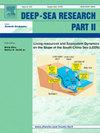秘鲁、本格拉和毛里塔尼亚氧最低带的不变镍动态
IF 3
3区 地球科学
Q2 OCEANOGRAPHY
Deep-sea Research Part Ii-topical Studies in Oceanography
Pub Date : 2025-08-15
DOI:10.1016/j.dsr2.2025.105531
引用次数: 0
摘要
镍(Ni)是生物必需的微量金属,用于脲酶、氢化酶和超氧化物歧化酶。全球海洋表面溶解(<0.2 μm) Ni (dNi)浓度在~ 2 nM以下很少耗尽。这与许多其他生物必需的微量金属,如铁(Fe)、钴(Co)和锰(Mn)的浓度形成鲜明对比。与强配体的络合作用,可能导致海洋生物无法获得dNi,以及由于与其他微量金属相比,细胞对dNi的需求较低,导致dNi消耗缓慢,这两种因素都被用来解释这种特殊的元素分布。在这里,我们报告了在东热带南太平洋(ETSP)的四次巡航(M135-M138)中对远洋dNi浓度(n = 1094)的新测量,以评估高产陆架区可变生物地球化学条件下的dNi动态。此外,我们还报告了沿16°S和17°S两个跨大陆架剖面的总颗粒和不稳定颗粒Ni浓度。ETSP沿秘鲁-智利大陆架具有高产的东部边界上升流系统。这与广泛的下伏氧最小带相吻合,导致持续的高磷酸盐和间歇性的高铁条件。与之前在不同季节、年份和El Niño-Southern振荡阶段的巡航相比,在秘鲁大陆架测量的绝大多数dNi浓度在2.2-10.8 nM范围内,具有高度可重复性的深度剖面。dNi浓度较低的证据仅在一个dNi低至1.3 nM的近岸地点发现。如此低的镍浓度似乎是罕见的。虽然与硅藻碎屑相关的生物Ni被埋在秘鲁陆架沉积物中,但秘鲁陆架上的生物Ni需求占每年上涌dNi通量的30%,而陆架沉积物中的埋藏约占上涌dNi通量的1 - 3%。在两个横架剖面上测量的总颗粒Ni浓度范围从低于检测到1.2 nM,并且相对于dNi浓度始终较低。平均而言,总颗粒Ni (TpNi)为dNi + TpNi的2.6%,不稳定颗粒Ni (LpNi)与TpNi保持紧密耦合(R2 = 0.99)。与全球海洋其他地方的情况一样,dNi与磷酸盐和硅酸浓度密切相关。相对于上涌的dNi供应,生物对Ni的需求有限,这解释了为什么在秘鲁沿海、陆架和近海地区,dNi剖面总体上相当均匀。结果表明,上游水体的dNi:磷比(0.673 mmol (mol P)−1)略低于平均值。在本格拉和毛里塔尼亚大陆架中发现了相似的dNi和dNi:磷比值分布,这加强了即使在极具生产力的大陆架环境中dNi剖面的相对不稳定性。本文章由计算机程序翻译,如有差异,请以英文原文为准。
Invariable nickel dynamics in the Peru, Benguela and Mauritania oxygen minimum zones
Nickel (Ni) is a bio-essential trace metal used in urease, hydrogenase and superoxide dismutase enzymes. The concentration of dissolved (<0.2 μm) Ni (dNi) in the surface ocean is rarely depleted below ∼2 nM globally. This is in stark contrast to the concentrations of many other bio-essential trace metals such as iron (Fe), cobalt (Co) and manganese (Mn). Both complexation with strong ligands, potentially rendering dNi unavailable to marine organisms, and slow depletion of dNi because of low cellular demand compared to other trace metals have been invoked to explain this peculiar elemental distribution. Here we report new measurements of pelagic dNi concentrations (n = 1094) from four cruises (M135-M138) in the Eastern Tropical South Pacific (ETSP) to evaluate dNi dynamics under variable biogeochemical conditions in a highly productive shelf region. We additionally report total and labile particulate Ni concentrations along two cross-shelf sections at 16° S and 17° S. The ETSP features a productive Eastern Boundary Upwelling System along the Peruvian-Chilean shelf. This coincides with an extensive underlying Oxygen Minimum Zone which leads to persistently high phosphate and intermittently high Fe conditions.
The vast majority of dNi concentrations measured across the Peruvian shelf were within the range 2.2–10.8 nM dNi with highly reproducible depth profiles compared to prior cruises in different seasons, years, and El Niño–Southern Oscillation phases. Evidence of lower dNi concentrations was only found at one inshore location with dNi as low as 1.3 nM. Such low dNi concentrations appear to be rare. Whilst biogenic Ni associated with diatom detritus is buried in Peruvian shelf sediments, biological dNi demand on the Peruvian shelf is <30 % of the annual upwelled dNi flux and burial in shelf sediments accounts for approximately 1–3 % of the upwelled dNi flux. Total particulate Ni concentrations measured on two cross-shelf sections ranged from below detection to 1.2 nM and were consistently low relative to dNi concentrations. On average, total particulate Ni (TpNi) was 2.6 % of dNi + TpNi with labile particulate Ni (LpNi) and TpNi remaining tightly coupled (R2 = 0.99). As is the case elsewhere in the global ocean, dNi remained tightly correlated with phosphate and silicic acid concentrations. Limited biological demand for Ni relative to the upwelled dNi supply explains why dNi profiles in general were quite homogenous across the Peruvian coastal, shelf and offshore regions. Finally, profiles of dNi suggested a slightly lower than average dNi:phosphorous ratio (0.673 mmol (mol P)−1) in the upper water column. Similar distributions of dNi and dNi:phosphorous ratios were found for the Benguela and Mauritania shelves reinforcing the relatively invariable nature of dNi profiles even in extremely productive shelf environments.
求助全文
通过发布文献求助,成功后即可免费获取论文全文。
去求助
来源期刊
CiteScore
6.40
自引率
16.70%
发文量
115
审稿时长
3 months
期刊介绍:
Deep-Sea Research Part II: Topical Studies in Oceanography publishes topical issues from the many international and interdisciplinary projects which are undertaken in oceanography. Besides these special issues from projects, the journal publishes collections of papers presented at conferences. The special issues regularly have electronic annexes of non-text material (numerical data, images, images, video, etc.) which are published with the special issues in ScienceDirect. Deep-Sea Research Part II was split off as a separate journal devoted to topical issues in 1993. Its companion journal Deep-Sea Research Part I: Oceanographic Research Papers, publishes the regular research papers in this area.

 求助内容:
求助内容: 应助结果提醒方式:
应助结果提醒方式:


